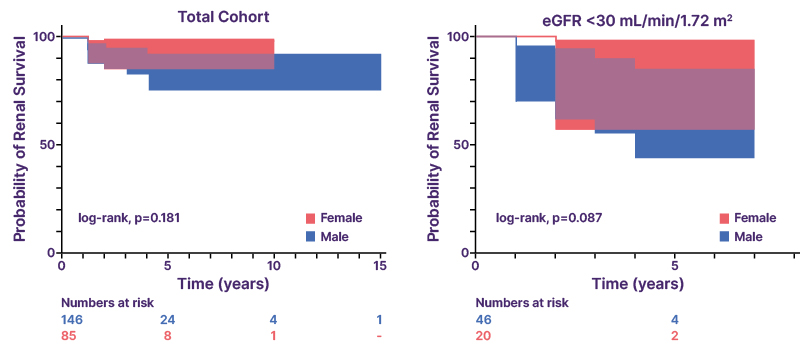BACKGROUND AND AIMS
Sex differences in kidney diseases have received limited attention. Research in this area is crucial for developing targeted prevention and intervention strategies that address the unique needs and risk factors of diverse populations. The purpose of this study was to investigate the impact of sex on infection rates and renal survival across different types of glomerulonephritis.1
METHODS
The authors conducted a retrospective, single-centre study at a reference centre for glomerular diseases, located in a tertiary hospital. They evaluated the prevalence of glomerular diseases among males and females in terms of clinical characteristics and long-term outcomes. Logistic regression analysis and time-to-event analyses were employed.
RESULTS
In total, 232 patients were included in the analysis: 63% were male and 37% were female. The most common glomerular disease in males was IgA nephropathy (29%), while females most frequently presented with anti-neutrophil cytoplasmic antibody-associated glomerulonephritis (19%) and focal and segmental glomerulosclerosis (19%). Notably, IgG4-related nephritis and membranoproliferative glomerulonephritis were observed only in males. At diagnosis, hypertension was more prevalent in males (71% in males versus 56% in females; p=0.035). There were no significant differences in the severity of kidney disease between sexes. The total cohort had a median estimated glomerular filtration rate (eGFR) of 51 mL/min/1.73 m2 (interquartile range [IQR]: 25–85) and a median proteinuria of 3 g/24 hours (IQR: 1–6). During the first year, females had a higher likelihood of infections compared to males (adjusted odds ratio: 3.0; 95% CI: 1.31–7.3; p=0.01) after adjusting for the type of immunosuppressive treatment. Renal recovery at 1 year was similar between the sexes, with males and females showing comparable increases in eGFR (mean±SD: 8±19 versus 11±21 mL/min/1.73 m2; p=0.50) and decreases in proteinuria (median [IQR]: 57% [0–90] versus 55% [0–83]; p=0.35). Over a median follow-up of 2 years (0.5–4), the 5-year overall survival rate was 90%, with no significant difference between males and females (log-rank: p=0.181). In the total cohort, the 5-year renal survival rate was 86%. However, in the subgroup of patients with baseline eGFR <30 mL/min/1.73 m2, males tended to have worse renal survival (log-rank: p=0.087) (Figure 1).

Figure 1: Renal survival analyses according to sex.
eGFR: estimated glomerular filtration rate.
CONCLUSION
This study highlights sex differences in glomerular diseases, particularly in infection rates and hypertension prevalence. Despite these differences, long-term renal survival rates, comprising proteinuria and eGFR evolution, were similar between sexes. However, males with severe kidney disease at baseline showed a trend towards worse renal survival.





